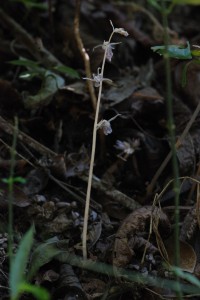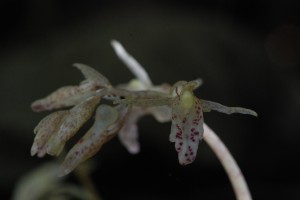Species of the Month – February 2015
Epipogium roseum (D.Don) Lindl.
The genus Epipogium J. G. Gmel. ex Borkh. is a small genus consisting of namely three species – Epipogium roseum (D.Don) Lindl., Epipogium aphyllum Sw. and Epipogium japonicum Makino. (The Plant List 1). However Dictionary of Orchid Genera notes four cool growing saprophytes2.
The name Epipogium is derived from Greek upward and beard. Referring to the turned-up lip and some resemblance to beard!
This cool growing perennial saprophyte, is a leafless orchid with very wide distribution. In southern parts of India, in the Southern Western Ghats region it is found flowering during the winter months of January-February. This orchid is found in soft humus-rich understory of wooded ares. It has hollow stems and subterranean horizontal tuberous rhizome. 
The lax inflorescence bears few to many flowers with plant usually reaching height of 20-25cm. Elsewhere the are seen to be growing to height of even one meter. The flowers and the spike have deep purple dots.
The rhizomatous growth seems to be dormant during the rest of period. Thus making it extremely difficult to observe during non-flowering time. Hence for non-trained eyes it becomes an easy plant to miss in the wilderness.
Some have referred to this orchid as “Ghost orchid”. It is believed that the lack of chlorophyl (achlorophyllous) in the species might have lead to such a name. Such green pigments or the chlorophyls believed to make a plant ‘alive’ with their greenness!
Recent increase in the development activities in forested areas are posing critical threats to not just such plants but to the entire habitat of such plants both orchids and non-orchids alike.

References:
1. http://www.theplantlist.org
2. The Marie Selby Botanical Gardens Illustrated Dictionary of Orchid Genera
3. Wild Orchids in Karnataka – Dr Anand Rao et al.
Article by: Ravee Bhat